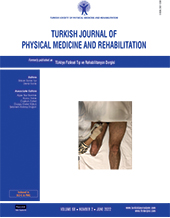Effectiveness of whole-body vibration exercise and core stabilization exercise in chronic non-specific low back pain: A randomized-controlled study
2 Department of Physical Medicine and Rehabilitation, University of Health Science, Kanuni Sultan Süleyman Training and Research Hospital, Istanbul, Türkiye
3 Department of Biostatistics, Istanbul University, Istanbul Faculty of Medicine, Istanbul, Türkiye
4 Department of Sports Medicine, Istanbul University, Istanbul Faculty of Medicine, Istanbul, Türkiye DOI : 10.5606/tftrd.2022.7060 Objectives: The aim of this study was to investigate the effectiveness of whole-body vibration exercise (WBVE) and core stabilization exercise (CSE) on pain, muscle strength, and functional recovery in patients with chronic non-specific low back pain (NLBP).
Patients and methods: Between June 2016 and July 2017, a total of 74 patients with NLBP (12 males, 62 females; mean age: 44.7±8.9 years; range, 24 to 64 years) were included in this prospective, randomized-controlled study. The patients were randomly assigned to WBVE group (WBVEG, n=25), CSE group (CSEG, (n=25), and home exercise group as the control group (CG, (n=24). All groups performed 24 sessions of exercise for a total of eight weeks. Clinical outcome was measured using the Visual Analog Scale (VAS), Roland-Morris Disability Questionnaire (RMDQ), computerized isokinetic muscle strengths (IMS) and progressive isoinertial lifting evaluation (PILE) test.
Results: The VAS and RMDQ scores in WBVEG and CSEG statistically significantly decreased (p<0.05). The difference between the pre-treatment and at three-month VAS scores during intense activity were significantly different in both WBVEG and CSEG than the CG (p<0.05). The IMS values, except for the isokinetic flexion total work (IKFTW), increased significantly in all three groups (p<0.05). The IKFTW values increased significantly in the WBVEG and CSEG (p<0.05). A statistically significant increase in the functional work performance with PILE was observed in all three groups (p<0.05). The differences between the pre-treatment and three-month PILE test (ground to back and back to shoulder) were significantly different in both WBVEG and CSEG than the CG (p<0.05).
Conclusion: In the treatment of chronic NLBP, WBVE and CSE appear to be effective in pain and functionality. Although there was a significant improvement in muscle strength and functional work performance in all three groups, greater improvements were observed in the WBVEG and CSEG than the CG.
Keywords : Chronic non-specific low back pain, core stabilization, isokinetic muscle strengths, whole-body vibration

















